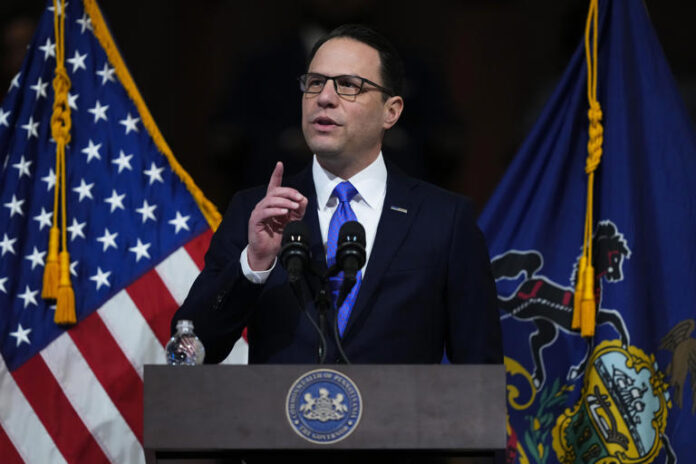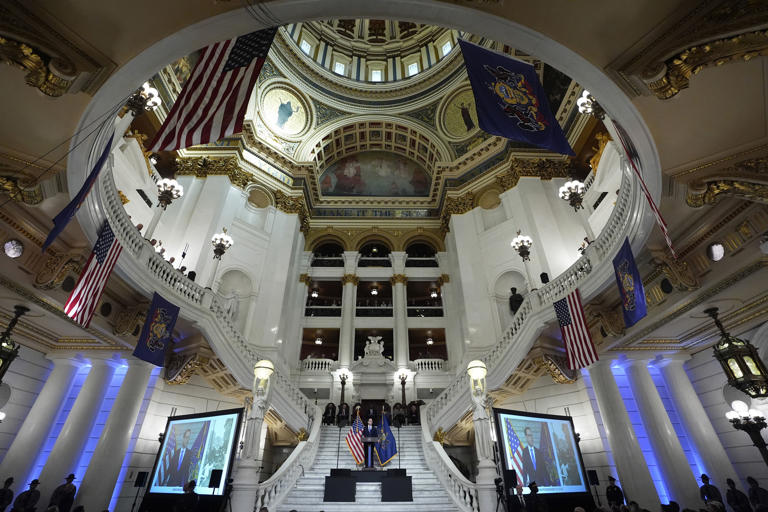
HARRISBURG, Pa.— Gov. Josh Shapiro’s second budget proposes significant increases to education and economic development and would regulate adult use marijuana, while leaning heavily on Pennsylvania’s flush reserves to underwrite his vision.
The Democrat on Tuesday unveiled his budget for the 2024-25 fiscal year, which begins on July 1, in front of a joint session of the House and Senate in the ornate Capitol Rotunda, watched over by a heavy police presence.
After a relatively modest first-year budget proposal, Shapiro returned in his second year with an admittedly “ambitious” $48.3 billion plan that marshals billions more for underfunded public schools, public transit, higher education and major industrial and high-tech projects to invigorate a slow-growing economy.
“I know that’s a bold vision, and some will reflexively be opposed, saying, ‘We can’t afford that,’” Shapiro told lawmakers during an 87-minute speech. “But I would argue we can’t afford not to invest right now.”
Much of Shapiro’s plan will face stiff resistance in the Republican-controlled Senate. There, Senate Majority Leader Joe Pittman, R-Indiana, criticized the spending as “absolutely fiscally irresponsible and unsustainable.”
Democrats who control the House applauded Shapiro’s plan. The chambers will begin budget hearings in two weeks.
With a nod to his burgeoning catchphrase, Shapiro called on lawmakers “get more stuff done.”
Shapiro’s spending request would increase total authorized spending by 7% through the state’s main bank account, while tax collections are projected to increase by $1 billion, or 2%. The budget proposal holds the line on taxes, and instead uses about $3 billion in reserve cash to balance.
The proposal would shrink the state’s cash reserve from $14 billion to $11 billion, while public schools, higher education and human services would absorb much of the increase in spending.
A hefty boost to public schools is a cornerstone of Shapiro’s proposal, coming after a court ruling that found Pennsylvania’s system of school funding unconstitutionally discriminates against poorer schools.
Shapiro wants a $1.1 billion increase, or 14% more, for public school operations and instruction, meeting a school funding commission’s recommendation last month supported by his appointees. A significant portion, about $872 million, would go toward poorer schools, a proposal which drew enthusiasm from public school advocates and teachers’ unions.
Shapiro also wants more money for student-teacher stipends, mental health counseling, special education and school construction, as well as putting menstrual hygiene products in schools.
Shapiro said his plan delivers another $2 billion to public schools, when combined with savings from tighter limits on charter school reimbursements.
“This is ambitious,» Shapiro said to Democrats’ applause. «None of this is easy and all of it will require us to work together.”
However, he also reiterated his support for a private school voucher program — a proposal that is backed by Republicans, opposed by Shapiro’s fellow Democrats and that helped precipitate a monthslong budget fight last year.
With his “competitive spirit” in mind, Shapiro wants to catch up to other states that are ahead of Pennsylvania.
As a new revenue stream, Shapiro wants to legalize adult-use marijuana, following the example of neighbors Ohio, New Jersey and New York. Shapiro’s administration estimates the industry would eventually yield $250 million in additional annual revenue. He also called for expunging records of those incarcerated for marijuana, and using $5 million for restorative justice.
To bolster students continuing through post-secondary, Shapiro’s budget allots an extra $200 million, or 10% more, for the state’s higher education institutions, an acknowledgment that Pennsylvania lags nearly every other state in funding higher education. The extra money would come with a reimagined state-owned higher education system that distributes aid based on transparency and performance-based measures.
In addition to pushing for a $15 minimum wage and making higher ed more affordable, Shapiro wants to attract major industrial and high-tech businesses by borrowing $500 million for site development to entice industrial and tech businesses to choose Pennsylvania.
“We need to build a more competitive Pennsylvania that starts in our classrooms, runs through our union halls and our small businesses, through our farmlands and our high rises, our college campuses, and leads to a life of opportunity and a retirement with dignity,” Shapiro said.
Shapiro’s proposal would boost spending on home and community services for the intellectually disabled and autistic by about $200 million, or 12% more.

That’s about half the amount that advocates say is needed to fix a system beset by staffing shortages, low pay and a thousands-long waiting list.
Still, advocates applauded it.
“It’s the first large systemic effort at addressing this issue,” said Richard Edley of the Rehabilitation and Community Providers Association. ”This isn’t going to fix it, but at least it’s major step toward addressing it.»
Another significant investment would go to public transportation, increasing state aid by about $280 million, or about 20%. More than half of that would go to the Philadelphia-area Southeastern Pennsylvania Transportation Authority, or SEPTA.
Shapiro also wants to send $31 million more to help the Pennsylvania State Police maintain and update its fleet of vehicles and aircrafts. The proposal comes after prison escapee Danilo Cavalcante eluded hundreds of law enforcement officers for two weeks.
Specifically targeting gun violence, Shapiro is seeking millions more for to audit gun retailers and monitor social media for threats, to expand after-school programming for adolescents and to clean up shared spaces like parks and recreation areas that he said are most affected by gun violence.
Other funding requests target housing needs, such as home repair subsidies and those facing eviction to have legal counsel, and health care programs, including money to prevent hospital closures and lower medical debt, prescription drug prices and the cost of health insurance.






